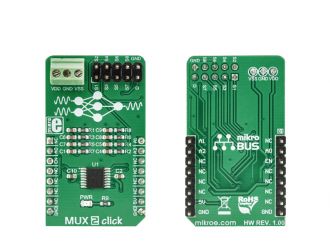
We strongly encourage users to use Package manager for sharing their code on Libstock website, because it boosts your efficiency and leaves the end user with no room for error. [more info]

Rating:
Author: MIKROE
Last Updated: 2018-11-23
Package Version: 1.0.0.0
mikroSDK Library: 1.0.0.0
Category: DAC
Downloaded: 5232 times
Not followed.
License: MIT license
MUX 2 click is a Click board that switches one of the eight inputs to one output. It employs the MUX508, a modern CMOS analog multiplexing integrated circuit, produced by Texas Instruments.
Do you want to subscribe in order to receive notifications regarding "MUX 2 click" changes.
Do you want to unsubscribe in order to stop receiving notifications regarding "MUX 2 click" changes.
Do you want to report abuse regarding "MUX 2 click".


Library Description
The library includes function for set current active mux channel and function for enable or disble mux device.
Key functions:
void mux2_activeMuxChannel(uint8_t ch) - Functions for set active MUX channelvoid mux2_deviceEnable() - Functions for enable MUX deviceExamples description
The application is composed of the three sections :
void applicationTask()
{
mux2_activeMuxChannel(_MUX2_CHANNEL_S1);
Delay_ms( 5000 );
mux2_activeMuxChannel(_MUX2_CHANNEL_S2);
Delay_ms( 5000 );
mux2_activeMuxChannel(_MUX2_CHANNEL_S3);
Delay_ms( 5000 );
mux2_activeMuxChannel(_MUX2_CHANNEL_S4);
Delay_ms( 5000 );
mux2_activeMuxChannel(_MUX2_CHANNEL_S5);
Delay_ms( 5000 );
mux2_activeMuxChannel(_MUX2_CHANNEL_S6);
Delay_ms( 5000 );
mux2_activeMuxChannel(_MUX2_CHANNEL_S7);
Delay_ms( 5000 );
mux2_activeMuxChannel(_MUX2_CHANNEL_S8);
Delay_ms( 5000 );
}
Other mikroE Libraries used in the example:
GPIOAdditional notes and information
Depending on the development board you are using, you may need USB UART click, USB UART 2 click or RS232 click to connect to your PC, for development systems with no UART to USB interface available on the board. The terminal available in all MikroElektronika compilers, or any other terminal application of your choice, can be used to read the message.